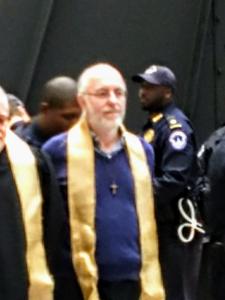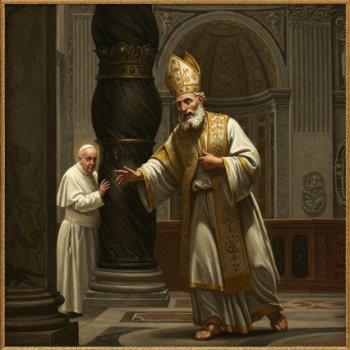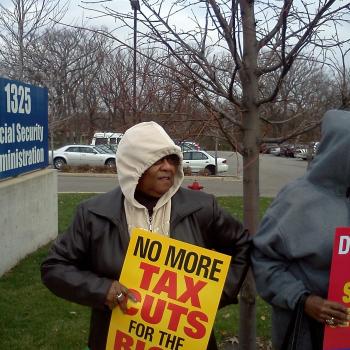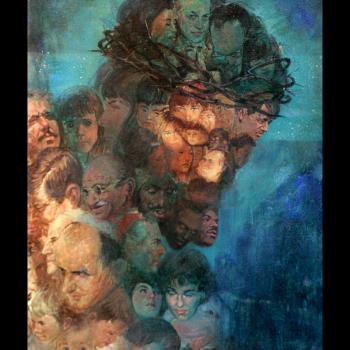 Last week I joined a group of faith leaders as we decided to “live church” in the Rotunda of the Senate office building. We sang, we prayed and we read scripture. We continued our church in the back of the police van as they led us away handcuffed and strapped in. Again we continued to pray, share stories and sing sitting in our jail cell. When I participate in such actions of civil disobedience, I am often asked why? What is it that leads me to put my freedom and health at risk for people that I do not even know? My reason for civil disobedience starts with a very simple answer: It is one way I practice my faith, just as Jesus and St. Francis did. When Jesus turned the tables over in the temple, he was committing civil disobedience. When St. Francis got naked in the public square he was committing an act of civil disobedience. It is church. There is a chant that we use a lot for marches: “tell me what democracy looks like, this is what democracy looks like.” Our mantra last week was:
Last week I joined a group of faith leaders as we decided to “live church” in the Rotunda of the Senate office building. We sang, we prayed and we read scripture. We continued our church in the back of the police van as they led us away handcuffed and strapped in. Again we continued to pray, share stories and sing sitting in our jail cell. When I participate in such actions of civil disobedience, I am often asked why? What is it that leads me to put my freedom and health at risk for people that I do not even know? My reason for civil disobedience starts with a very simple answer: It is one way I practice my faith, just as Jesus and St. Francis did. When Jesus turned the tables over in the temple, he was committing civil disobedience. When St. Francis got naked in the public square he was committing an act of civil disobedience. It is church. There is a chant that we use a lot for marches: “tell me what democracy looks like, this is what democracy looks like.” Our mantra last week was:
“Tell me what church looks like. This is what church looks like.”
Three years ago, I was part of a thirty-day hunger fast. I joined others on the Mall in Washington D.C. in a water-only hunger fast for immigration reform as part of Fast4families. I ended up fasting for 13 days and others lasted longer. All totaled the group fasted for 30 days. We started each day reading the passage from Isaiah: “Is this not the Fast I choose releasing those bound unjustly?” We started with 8 of us in a tent on the Mall. We ended up with over 200 joining us in the tent and over 10,000 fasting across the country. Some for a day, others for 20 or more days. Each day when a new person joined us, we formed a circle in our tent, welcomed them with prayer and asked them to share their stories. One day Cardinal McCarrick came into our circle, stood quietly for a few minutes and said: ”You have created sacred space here. Now go and make the entire Earth sacred ground.” Each evening we ended our day with a gathering. We had song, we prayed and we shared stories.
“Tell me what church looks like. This is what church looks like.”
Several years ago at St. James parish in Stratford, Connecticut a small group of parishioners came together and decided that instead of occasionally just collecting clothes and dropping them off at a homeless shelter, they would go to where the homeless congregated. They would bring things like toiletries and socks. They would not just drop off packages, but would spend time engaging with the homeless, hanging out with them, sharing stories, and building relationships. What started out as a small group of 8 or 9 folks deciding to spend time with the homeless has now grown to 50-60 folks coming together, praying, loading up their trucks and cars with clothes, toiletries, toys, food and anything else. These necessities are brought to a place underneath a bridge where the homeless stay and hang out. It ends with the parishioners and the homeless gathering together for prayer. This outreach continues to this day at St. James.
Sometimes we would wonder are we making a difference? I remember one time I was there and talking with this young man named John. I had met him before and heard his story. John was down on his luck, had made some bad decisions and was now living on the street and at a homeless shelter. He looked a little anxious so I asked him what was wrong. John said that he was really trying to get his life under control. He had a job interview this week and felt that it could be just what he needed to get back on track. I told him that was great and asked what he was anxious about. John said that he did not have any clothes to wear to the interview. Everything he owned was dirty and ragged. He didn’t think there was any way he would get the job wearing those clothes. I noticed that John was about the same size as me, so I went home to grab slacks, a shirt and tie, and a pair of shoes. I brought them back and gave them to John. A few weeks later I was back at the bridge and saw John. He came up, gave me a big hug, and thanked me. I asked him how he made out and he said he got the job and had started the previous week. John said “I brought your clothes back.” I told him to keep them for the next person.
“Tell me what church looks like. This is what church looks like.”
It is ironic that when you ask people what church they attend, they usually identify a building. Today we often think about church as a building. A place where we go maybe once a week for about an hour. The word “church” comes from the Greek word ‘ekklesia’. It is actually found 114 times in the New Testament. It is often defined, not as a building but as an assembly. In Ancient Athens an ‘ekklesia’ was the assembly of all free men. The root meaning of “church” is not that of a building, but of people. However, over the years, this essential idea has been lost. St. Paul refers to the church not as a building, but a body of believers. St. Paul called the church the Body of Christ, using a metaphor of the human body. The various parts–eyes, ears, nose, hands, feet, and others–have individual jobs, Paul said. Each is also part of the whole body, just as each believer receives spiritual gifts to function in their individual role in the body of Christ, the church.
As a part of the Franciscan family and a Christian I try to lead with my faith, as do so many others who do the work of justice and advocacy. Catholic social teaching, and specifically Franciscan spirituality, is built on tenets of social, environmental, and economic justice. The full passage in Isaiah, from which the fasters in the tent read, states: “Is this not, rather, the fast that I choose: releasing those bound unjustly, untying the thongs of the yoke; Setting free the oppressed, breaking off every yoke; Is it not sharing your bread with the hungry, bringing the afflicted and the homeless into your house; Clothing the naked when you see them, and not turning your back on your own flesh; Then your light shall break forth like the dawn, and your wound shall quickly be healed; Your vindication shall go before you, and the glory of the LORD shall be your rear guard. Then you shall call, and the LORD will answer, you shall cry for help, and he will say: ‘Here I am!’ If you remove the yoke from among you, the accusing finger, and malicious speech. If you lavish your food on the hungry and satisfy the afflicted, then your light shall rise in the darkness, and your gloom shall become like midday.”
I think that too often we view church the same way we view Heaven. We think of it as a place to go, somewhere else. We hope that when we die we will “go to Heaven” just like we “go to church.” In Matthew 3 we are told “The Kingdom of Heaven is at hand.” The Greek word that is translated “at hand” is engizo. It literally means to draw near to something. So when Jesus said the Kingdom of Heaven is at hand, did he mean that we have to go some place far away to get there? Imagine what would happen if instead of going to church we started “living church” and instead of waiting to go to Heaven we started “living in Heaven” now.
Peace and All Good.
















